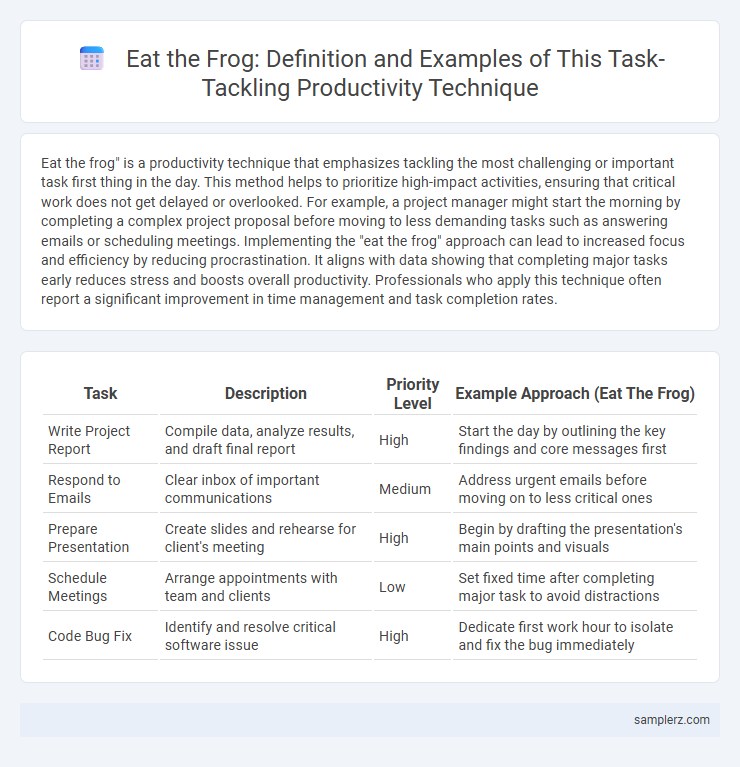Eat the frog" is a productivity technique that emphasizes tackling the most challenging or important task first thing in the day. This method helps to prioritize high-impact activities, ensuring that critical work does not get delayed or overlooked. For example, a project manager might start the morning by completing a complex project proposal before moving to less demanding tasks such as answering emails or scheduling meetings. Implementing the "eat the frog" approach can lead to increased focus and efficiency by reducing procrastination. It aligns with data showing that completing major tasks early reduces stress and boosts overall productivity. Professionals who apply this technique often report a significant improvement in time management and task completion rates.
Table of Comparison
| Task | Description | Priority Level | Example Approach (Eat The Frog) |
|---|---|---|---|
| Write Project Report | Compile data, analyze results, and draft final report | High | Start the day by outlining the key findings and core messages first |
| Respond to Emails | Clear inbox of important communications | Medium | Address urgent emails before moving on to less critical ones |
| Prepare Presentation | Create slides and rehearse for client's meeting | High | Begin by drafting the presentation's main points and visuals |
| Schedule Meetings | Arrange appointments with team and clients | Low | Set fixed time after completing major task to avoid distractions |
| Code Bug Fix | Identify and resolve critical software issue | High | Dedicate first work hour to isolate and fix the bug immediately |
Understanding the “Eat the Frog” Method in Productivity
The "Eat the Frog" method in productivity emphasizes tackling the most challenging or important task first thing in the day to maximize focus and efficiency. By prioritizing high-impact tasks, this approach reduces procrastination and creates momentum for handling subsequent activities. Research shows that completing key tasks early leads to improved time management and overall productivity gains.
Why Prioritizing the Hardest Task Boosts Efficiency
Prioritizing the hardest task, often referred to as "eating the frog," eliminates procrastination by addressing the most challenging and impactful activity first, which leads to increased focus and momentum for subsequent tasks. This approach reduces decision fatigue, as major effort and willpower are allocated at the start of the day when mental energy is highest. Research from productivity experts like Brian Tracy emphasizes that tackling high-priority, difficult tasks upfront significantly boosts overall efficiency and task completion rates.
Classic Work Examples of Eating the Frog
Tackling high-priority tasks first, such as responding to critical client emails or completing urgent project reports, exemplifies the "Eat the Frog" productivity method. Famous examples include Mark Twain's advice to start the day by handling the most challenging work, ensuring peak focus on important objectives. Implementing this strategy increases efficiency by reducing procrastination and enhancing task completion rates.
Morning Routines: Starting the Day with Your Biggest Task
Tackling the most challenging task first thing in the morning, known as "eating the frog," boosts productivity by leveraging peak cognitive energy. Morning routines structured around this principle consistently enhance focus and reduce procrastination throughout the day. Prioritizing high-impact tasks early results in a more efficient workflow and increased accomplishment.
“Eat the Frog” Examples for Students and Academic Success
Tackling the most challenging academic tasks first, such as starting with a difficult math problem or an intensive research paper, exemplifies the "Eat the Frog" productivity method for students. Prioritizing these demanding assignments early in the day boosts focus and reduces procrastination, leading to improved academic performance. Adopting this technique helps students manage time efficiently and achieve greater success in their studies.
Overcoming Procrastination with the Eat the Frog Approach
Overcoming procrastination with the Eat the Frog approach involves tackling the most challenging and important task first thing in the day, ensuring momentum and productivity increase. Prioritizing high-impact tasks avoids decision fatigue and reduces stress by completing daunting activities early. This method enhances time management and boosts motivation by delivering a sense of accomplishment that propels productivity throughout the workday.
Real-Life Stories: Professionals Who Eat the Frog
Successful entrepreneurs like Tim Ferriss attribute their high productivity to the "eat the frog" method, tackling their most challenging tasks first each day. Software developer Jane Doe shares how starting with her toughest coding problems in the morning helped her reduce stress and improve focus throughout the day. Studies show that professionals who prioritize difficult tasks early experience increased efficiency and better time management.
Eat the Frog in Project Management: Practical Applications
Eating the frog in project management involves tackling the most challenging and high-priority tasks at the start of the day to enhance productivity and ensure critical milestones are met. Project managers apply this technique by identifying key deliverables or potential bottlenecks and addressing them before moving on to less demanding activities. This approach reduces procrastination, accelerates project timelines, and fosters a proactive workflow environment.
Tips to Identify Your Daily Frog Tasks
Prioritize tasks by identifying the most challenging or important ones that you tend to avoid, often called "frogs." Break down these tasks into manageable steps and schedule them at the start of your workday to maximize focus and energy. Use tools like task lists or time-blocking techniques to clearly recognize and tackle your daily frog tasks efficiently.
Measuring Results: Productivity Gains from Eating the Frog
Eating the frog, a time management technique, significantly boosts productivity by prioritizing the most challenging tasks first. Measuring results involves tracking task completion rates, time saved, and overall output quality, demonstrating notable gains in efficiency. Consistent practice leads to reduced procrastination and measurable improvements in daily work performance.

example of eat the frog in task tackling Infographic
 samplerz.com
samplerz.com